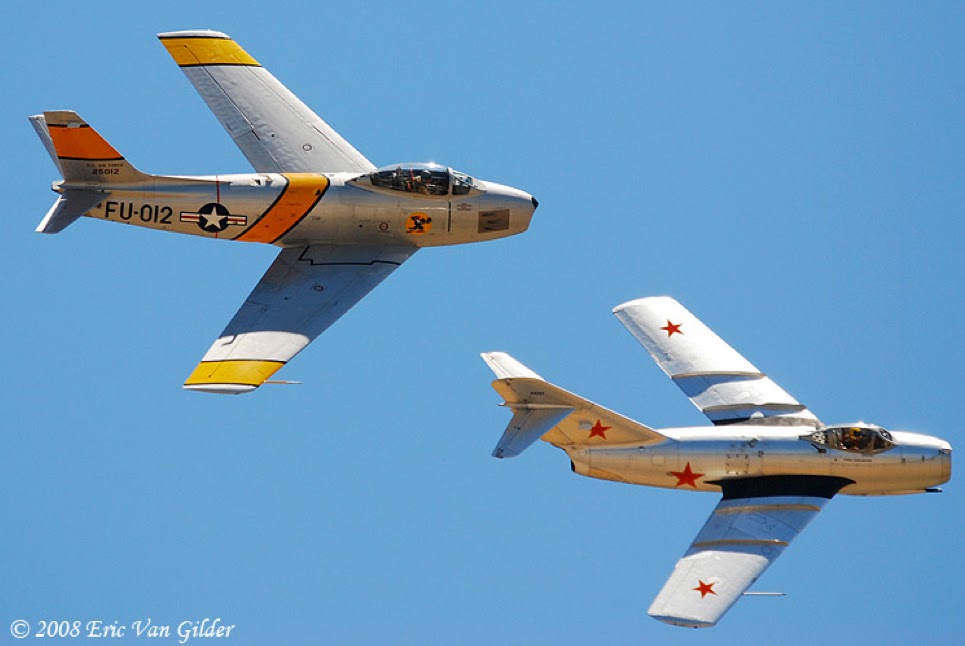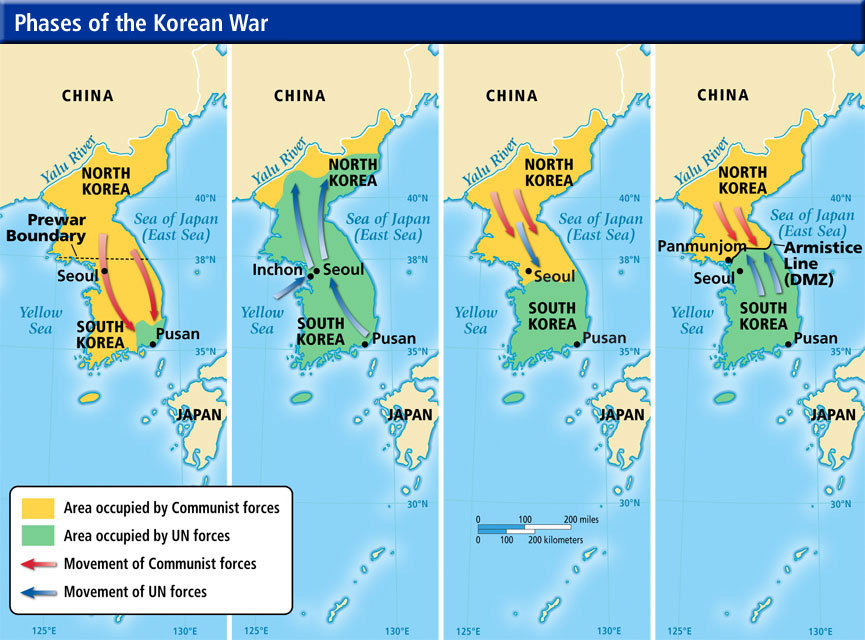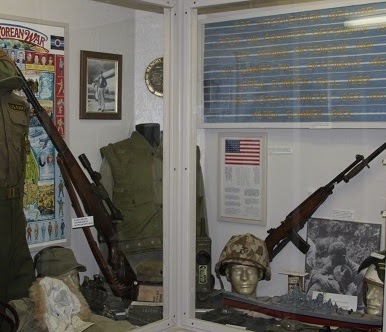The Museum's Korean War (Conflict) display shows the types of uniforms, equipment, and weapons used in the war. Many new weapons were introduced during this period, such as the 3.5 in "Bazooka" Rocket launcher and ammunition created to stop the Russian supplied T-34 tank.
Cold weather uniforms are also included in the display, some of which were used for the first time in the Korean War, including Parkas, "Bunny Hats", and "Boonie Boots", (Artic- shoe Pac).Other items in the display include Rifles (M-1 Garand Sniper rifle) M-1 Carbine, BAR (Browning Automatic Rifle), and maps and charts used in the war.
The Korean War also introduced jet fighter aircraft used for the first time by both sides in aerial combat. This includes the Russia MiG-15, which outclassed the US F-80 Shooting Star and F-84 Thunder jet until the arrival of the F-86 Saber jet. UN pilots achieved a kill ratio of 10-1 over the MiG's. The Communist air force was never utilized to support their efforts on the ground.
The B29 Superfortress also played an important role in supporting U.N. Troops (Area Bombing), until the Russian pilots (disguised as Chinese) flew their MiG-15's from airfields in Manchuria, which were off limits to UN Pilots in Korea.

U.S. Veterans Memorial Museum. KOREAN WAR (CONFLICT) 1950-1953:
The Korean peninsula, which from space looks somewhat like Florida, is roughly equivalent in size to Great Britain. A great north- south wall of mountains reaches down the eastern coast from the Yalu River in the north to the port of Pusan in the south, while smaller ranges and hills extend inland. The west coast consists of broad, flat, muddy plains.
Geography has condemned Korea, as it had Poland, to chaos and conflict. Like all buffer states, Korea has suffered the disastrous consequences of frequent invasions. Seen from China or Russia, the country is the gateway to the Asian heartland. For Japan, Korea is the bridge that directly leads to the home islands. From Korea, any one of these historically imperialistic powers can threaten the other two. Although Korea is on the same latitude as San Francisco and Philadelphia, the weather is harsh, especially during the bleak winters when bitter, biting Siberian winds blow down from the Asian interior. Summers are hot and moist with a monsoon season that turns Korea's unpaved roads into quagmires. Temperatures extremes range from 105 F, to minus 40 F.
Korea is known as the Hermit Kingdom. The majority of the large population lives in poverty. Most Koreans live off the land, growing rice, barley, and soy beans. They follow a variety of religious beliefs including nature-spirit worship, Buddhism, Confucianism and Christianity.
The Koreans are an ancient, hardy, and talented people who developed movable metal types before Gutenberg, devised a 26 - letter alphabet (although it failed to gain wide usage), built an ironclad ship, and produced a body of skilled workers. The peninsula was a pathway for cultural, educational, religious, scientific, and industrial exchanges between Japan and continental Asia. Twice in the late sixteenth century, Japan invaded Korea, caused appalling levels of brutality, death, and destruction, and took many of the Korean skilled artisans back to Japan.
In 1950 the Americans arrived in the thousands and found Korea to be a country of high, rough-hewn mountains, steep and narrow valleys, wide deep rivers, endless hills, thread-like paths, bad roads, heavy rain and deep snow, rice paddies and mud plastered villages. Korea lacked charm or natural beauty, and was neither quaint nor rustic. It should be the last place on earth anybody would want to fight a war.
Following World War II, the Korean Nation began a new historical era. It had struggled for forty years as a Japanese Colony; now it would begin a new struggle as a pawn in the newly created Cold War. Representatives of the Soviet Union and United States met in Potsdam during the summer of 1945 and decided they could best handle the surrender of Japanese forces in Korea by dividing the country at the 38th Parallel. In August, the Russian Officers accepted the Japanese surrender north of the 38th Parallel; in September the Americans Officers did the same south of the 38th Parallel.

Korea invasion 1950
Shortly after the Japanese capitulation, the Soviet Union abruptly stopped movement across the 38th Parallel. Korea, without international agreement or treaty, found itself divided into a Communist north and a Democratic South. Unexpectedly, the 38th Parallel had become the political frontier between two nations. Above the border, the Soviet Union prepared North Korea to become one of its satellite states. Below the border, the United States prepared Korea to become a free nation.
Between 1945 and 1950, the USSR trained and equipped the North Korea Peoples Army (NKPA or In Min Gun) while the USA trained and equipped the republic of Korea's (ROK) Army. Soon, North Korea had a large, rigorously trained and aggressive military force well supplied with Russian arms, artillery, armor, and propeller-driven fighter aircraft. Moreover, nearly all of its commissioned Officers and noncommissioned officers were combat veterans of the Chinese civil war or Manchurian guerrilla operations. Below the Parallel, South Korea faced this menace with a smaller and less equipped armed force.
By 1950, the balance of power had dramatically shifted to the north. In late spring of that year, the North Koreans had 150 Russian built T-34 tanks, while the South Koreans had zero; the North Koreans had three types of artillery, the South Koreans one. In actual numbers of divisional artillery pieces, the NKPA exceeded the ROK by three to one. The North Koreans had a small tactical Air Fore, and the South Koreans had none. The North Koreans had seven full-strength combat divisions, while the South Koreans had four. The North Koreans possessed 89,000 assault troops, and the South Koreans had 65,000.

Russian T34 Heavy Tank
The North Koreans, emboldened by their military might and Soviet Support, resolved to confront their neighbor in a decisive struggle for national supremacy. Determining that the United States would have too much to lose if it interfered, the North Korean Peoples Republic set out to unify all of Korea by direct military action.
During the period of June 14th-24th, North Korea secretly moved within range of the 38th Parallel, with seven infantry divisions, one armored brigade, one separate infantry regiment, one motorcycle regiment, and one border constabulary brigade. By the 25th, a rainy and blustery Sunday in Korea, the Communists had 90,000 combat troops poised within striking distance of South Korea.
June 24 1950: North Korea forces, consisting of seven divisions and five brigades with a force of 100-150 Soviet planes, crossed the 38th parallel at 4 A.M. Korean time on June 25. The main attack took place down the Pochon-Uijongbu-Seoul corridor. Other attacks were launched in the Ongjin Peninsula in the west, against Ch'unch'on in the eastern mountains, and down the east coast road. The ROK forces initially numbered only five divisions with no air force or armor available.
June 25: At 3:00 A.M. (EDT) the U.S. requested an immediate meeting of the Security Council. The U. N. Commission on Korea (UNROK) determined that the situation was extremely threatened world peace and security. At 2:00 P.M., the Security Council met and adopted a resolution determining that the attack constituted a breach of peace and called for a cease fire and the full withdrawal of North Korean forces from the 38th Parallel. All members supported the resolution except Yugoslavia, which abstained. The USSR representative did not attend. President Truman called the situation serious but not alarming. Gen. Douglas McArthur, was authorized to furnish military supplies to the ROK.

Korean War sequence of events
June 27
At noon (EDT) President Truman announced that he had ordered U. S. air and sea forces to give ROK troops cover and support in accordance with Security Council resolution of June 25. The Security Council met at 3:00 P.M. and adopted a resolution recommending the UN members furnish all necessary assistance to the ROK to repel the attack.
June 28
The North Koreans took Seoul and as a result the ROK capital reportedly moved to Taejon. UN forces were placed under the command of General McArthur. The UN force comprised four under-strength American Divisions that had been stationed in Japan at the end of World War II. These Units, the 7th, 24th, and 25th Infantry Divisions and the 1st Cavalry Division (infantry), were under the direct command of Lt. Gen Walton Walker's Eight Army. This little Army averaged about 70 percent of its full war strength, with each regiment less than one battalion. Its World War II equipment was old and worn.
June 29
President Truman claimed that U.S. action in Korea should be considered a police action, not a war.
June 30, 1950
Reports showed that ROK forces still held Inchon. The fate of Suwon remained uncertain. President Truman authorized General Mc Arthur to use ground troops in Korea.
On July 4, 1950, two rifle companies, B and C, one-half of Headquarters Company, one section of 75mm recoilless rifles, and, two 4.2 inch mortars, under their commander Lt Colonel Charles "Brad" Smith, were air-lifted from Japan to Pusan Korea. They were from the 21st Infantry Regiment, 24th Infantry Division, Japanese occupation duty. A train took them north where they were deployed near Osan, about 35 miles south of Seoul. Each rifleman had 120 rounds of ammunition and each man had two days of "C" rations. They stood 540 men strong.

PUSAN PERIMETER
The UN Forces dug in along their meager toehold in southeast Korea, which became known as the Pusan Perimeter. The western edge manned by U.S. troops ran from the Korea Straight north along the Natkong River for about 85 miles. Just north of Taegu, the line turned east and ran for about 50 miles to Pohang on the Sea of Japan. ROK troops defended the mountainous sector. They had naval gunfire support from U. S. and British ships.
The Pusan Perimeter was not a series of two-man foxholes every few yards- there were too few troops for this-but rather an offensive - defense. Observation post were strung along the front and when enemy movements were detected, troops located in strong points well to rear would come forward to push the NKPA back across the Natkong River.
THE INCHON LANDING:
This clever and risky operation of landing at Inchon, far behind enemy lines, was conceived by General McArthur on his personal reconnaissance to Korea on June 29, but had to be postponed to commit the troops he had planned to use in order to delay the NKPA steamroller pushing down the peninsula.
The Inchon Landing became one of the most brilliant moves in American military history. The slaughter of slugging it out head-to-head and toe-to-toe around the Pusan Perimeter would cease, thousands of casualties would be prevented, and a decisive victory would be won.
NORTH KOREAN INCURSION:
The Inchon Landing had changed the fortunes of war almost overnight, insuring the NKPA defeat. Lt General Matthew Ridgeway said if it had been suggested that McArthur could walk on water, most would have believed it. But now the Far East
Command made a serious mistake.
On September 27, he was ordered by the Joint Chiefs of Staff to cross the 38th parallel without fanfare and with little publicity. The objective was to destroy the remaining NKPA forces and unite the North under the government of South Korea. With some reluctance, the UN approved the action. Some of the reasons given (NSC-81) were (1) 2,500 American and 25,000 ROK POW's were being held, (2) Red China, which had massive economic and social problems, and with an Army lacking armor and heavy artillery, and air support, would probably not intervene; (3) taking North Korea away from the Russian influence would increase U.S. chances of rapprochement with China, (4) if left intact North Korea might invade again after it recovered, (5) Americans were outraged at the atrocities committed by the enemy against U.S. forces. Needing additional port facilities to supply X Corps and Eighth Army, and to meet the possibility of stubborn resistance at the North Korean capital of Pyongyang. McArthur withdrew the X Corps for the landing at Wonsan on the east coast. It would attack across the "narrow waist" of Korea toward Pyongyang from the east while Eighth Army attacked from the South. It was a tragic mistake not only because of the delay it caused which allowed some recovery among some NKPA units and time for Chinese to deploy, unseen in Korea. Resistance was so light and Pyongyang was taken by the 1st Cav Div and the 1st ROK Division October 19. The ROK troops advanced so rapidly up the east coast that they took the landing site at Wonsan before X Corps arrived by sea.

North Korean T-34
CHINESE INTERVENTION
When the nationalist were defeated (October 1949) and the People's republic of China was established by the Communist. U. S, .Far East policy changed. When the Inchon Landing changed the whole course of the war in Korea. Stalin urged the Chinese to intervene, promising them air power. General PengTeh-huai, who would command Chinese Communist Forces (CCF) in North Korea, said if the Americans reached the Yalu River (border between Korea and Manchuria, they would find an excuse to invade China. Moving at night and using excellent camouflage troops of CCF Forth Field Army (200,000) already in Manchuria crossed into Korea while troops of the Third Field Army (120,000) headed north to reinforce them These forces were undetected by UN aerial reconnaissance.
The UN forces continued their advance and on October 25 at Ulsan (oon-san) about 70 miles north of Pyongyang, the ROK 15th Regiment was stopped by the Chinese who had crossed the border on October 18 and deployed in the mountains. After routing several U.S. and ROK units, the Chinese mysteriously withdrew. Prisoners sent back to headquarters were confirmed to be Chinese. Intelligence estimated that there were no more than 27,000 (later upgraded to 70,000) Chinese in Korea.
The advance of the Eighth Army (118,000) resumed on November 24 despite shortage of supplies, including winter clothing. Some riflemen had as few as 16 rounds of ammunition. The bulk of the 120,000 CCF in the area hit the Marines and Army Task Force. Winter had set i with temperatures of 24 degrees below zero. Flesh stuck to metal. Weapons and vehicles froze.
The CCF forced the U.N. out of North Korea, but at a tremendous cost at a Kill ratio of 20 to 1. The X Corps was evacuated by sea with almost 100,000 civilians unwilling to live under the Communists coming with them. Because of its shattered right flank, the Eighth Army retired to a more narrow portion of the peninsula about 45 miles south of the 38th parallel where they were joined by X Corps
Mc Arthur was relieved of command in April 1951. Seoul was retaken in March of 1951 as UN forces continued to push northward. An April CCF counteroffensive failed to recapture the capital and in May in the east central Korea, their attack became known as the May Massacre because of their heavy losses. The UN asked for an armistice at the parallel, but the elated Chinese, who had gained world acclaim, refused to seriously consider the proposal. Pouring in more troops, their goal was the expulsion of U.N. Forces in South Korea. General Ridgeway assumed the command of the Eighth Army after the death of General Walker and soon had his troops turned around. The U.S. began pushing the CCF and NKPA back into North Korea.
The Chinese had suffered an unbelievable number of casualties and were ready to talk peace. The Soviets had lost face in the communist world. The U.S. had troops to aid its ally, South Korea. Chinese influence in North Korea Increased as Russia's decreased.
TRUCE TENT AND THE FIGHTING FRONT: The talks began on July 10, 1951. Expecting a cease fire line to be exactly on the parallel, the communists balked when the UN refused to move back from their good defensive positions just north of the line where none existed at the parallel. The UN renewed their offensive action, which had been curtailed during the peace talks. The pressure brought the communists back to the table on November 27, 1951, and a slow, slow progress was made. Most of the American POW's were captured during the first six months of the war. About 50 percent died due to wounds, disease, exposure and malnutrition.
COMMUNIST MILITARY AGGRESSION WAS DEFEATED IN KOREA.
North Korea remains a closed totalitarian state, widely regarded as a threat to world peace. South Korea is an economic miracle. By 1995, she had become the world's fourteenth strongest economy and the fifth largest producer of automobiles.



